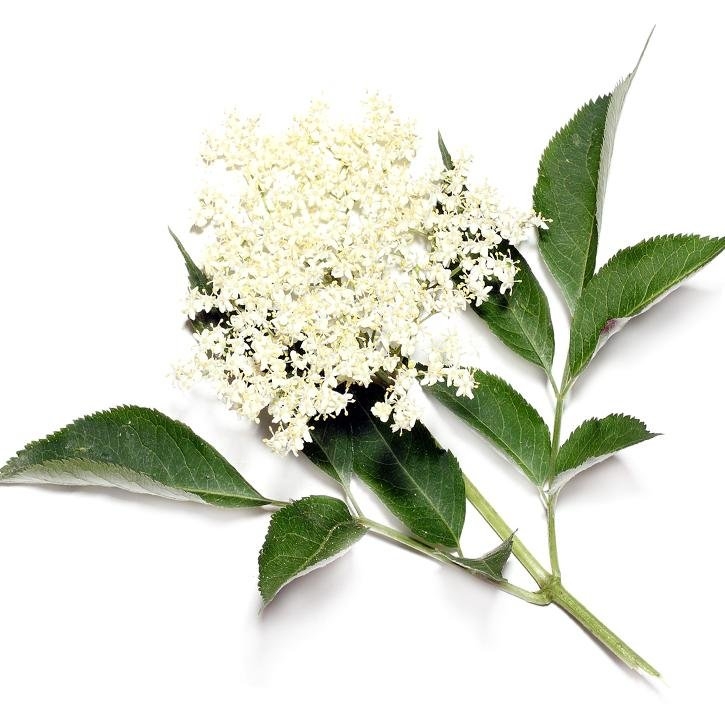Description
Shrub, 2-5 m high (sometimes it might become a tree and grow up to 10 m), with ligneous trunk and branches. The trunk is coated by a grayish verrucose bark. Branches are light brownish covered by lenticels and a spongy and soft core. Branches remain green during the whole first year, but after that they become ligneous. Leaves are caducous and opposite, arranged in pairs with oval-lanceolate, acuminate folioles of 10-15 cm long. The edge is serrated, the face glabrous, downy beneath and an acute fragile apex. It has 5 to 7 folioles per leaf.
Flowers are white, grouped in corymbose umbels (umbrella-shaped), 10-20 cm diameter. They are displaced at the top of the branches; calyx is tubular and five-toothed, and the corolla is five-lobed with five petals and five stamens in yellowish-white. They have a heavy agreeable odor, but have no nectar, therefore, no insects around them. Fruits are grouped in hanging racemes. Black or purplish, round or globose berries, 6-8 mm diameter, reddish at the beginning and black when ripe. Fruit holds inside 3-5 seeds. The pulp has substances that inhibit seeds germination. For that reason, when the fruits are harvested they have to be thoroughly cleansed immediately. It belongs to the Caprifoliaceae family.
It spontaneously grows in humid soils, near rivers and forests in Europe, North Africa and East Asia. It is distributed in mild and cold weather zones in America. It is found in groves, at the edge of brooks, streams, hedges and steep banks. It is common at the half north of the Iberian Peninsula. Elderberry blooms between April and June, depending on the altitude and latitude.
Part used
Flowers (mainly), fruits and sometimes the inner bark (liber).
Indications
*Flowers:
- Respiratory disorders: common cold, flu, bronchitis, tonsillitis, laryngitis, feverish conditions.
- Skin disorders: against childhood eruptive diseases.
- Osteoarticular and gums inflammation.
- Edemas, water retention.
- Varicose veins, hemorrhoids, retinopathies, capillary fragility.
- Eye washes against conjunctivitis; blepharoconjunctivitis, dark rings under the eyes.
- Skin lesions with no inflammation, burns, superficial skin infections, eczemas, hives, etc.
- In gargles to treat mouth and throat infections.
- In compresses to lower fever.
*Bark (liber):
- Urinary infections: urolithiasis and cystitis.
- Rheumatism and gout.
- Edemas and oliguria.
*Fruits:
- Constipation (fruits juice).
- Rheumatism and trigeminal neuralgia.
- Due to the presence of anthocyanosides, fruits are used to obtain food coloring.
Bibliography
- Benigni, R; Capra, C; Cattorini, P. Piante Medicinali. Chimica, Farmacologia e Terapia. Milano: Inverni & Della Beffa, 1962, pp. 1421-4.
- Bézanger-Beauquesne, L; Pinkas, M; Torck, M. Les Plantes dans la Therapeutique Moderne. 2ª. Paris: Maloine, 1986, p. 382.
- Bézanger-Beauquesne, L; Pinkas, M; Torck, M; Trotin, F. Plantes Médicinales des Regions Tempérées. Paris: Maloine, 1980, pp. 361-2.
- British Herbal Pharmacopoeia. Vol. I. Bournemouth, Dorset: British Herbal Medical Association, 1990, pp. 41-2.
- Fernández, M; Nieto, A. Plantas Medicinales. Pamplona: Ediciones Universidad de Navarra, 1982, p. 158.
- Lastra, JJ; Bachiller, LI. Plantas Medicinales en Asturias y la Cornisa Cantábrica. Gijón: Ediciones Trea, 1997, pp. 227-8.
- Mulet, L. Flora tóxica de la Comunidad Valenciana. Castellón: Diputación Provincial, 1997, pp. 387-8.
- Paris, RR; Moyse, M. Précis de Matière Médicale. Tome III. Paris: Masson, 1971, pp. 384-5.
- Peris, JB; Stübing, G; Vanaclocha, B. Fitoterapia Aplicada. Valencia: M.I. Colegio Oficial de Farmacéuticos, 1995, pp. 463-4.
- Peris, JB; Stübing, G; Figuerola, R. Guía de las Plantas Medicinales de la Comunidad Valenciana. Valencia: Las Provincias, 1996, p. 73.
- Rivera, D; Obón, C. La Guía Incafo de las Plantas Útiles y Venenosas de la Península Ibérica y Baleares. Madrid: Incafo, 1991, pp.146; 936-40.
- Trease, GE; Evans, WCh. Farmacognosia. México D.F.: Interamericana--MacGraw-Hill, 1991, pp. 450; 581.
- Van Hellemont, J. Compendium de Phytotherapie. Bruxelles: Association Pharmaceutique Belge, 1986, pp. 361-3.
- Villar, L; Palacín, JM; Calvo, C; Gómez, D; Montserrat, G. Plantas Medicinales del Pirineo Aragonés y demás tierrras oscenses. 2ª. Huesca: Diputación Provincial, 1992, pp. 29; 211; 283.
- Wichtl, M. Herbal Drugs and Phytopharmaceutical. A Handbook for Practice on a Scientific basis. Stuttgart: Medpharm Scientific Publishers, 1994, pp. 446-50.
